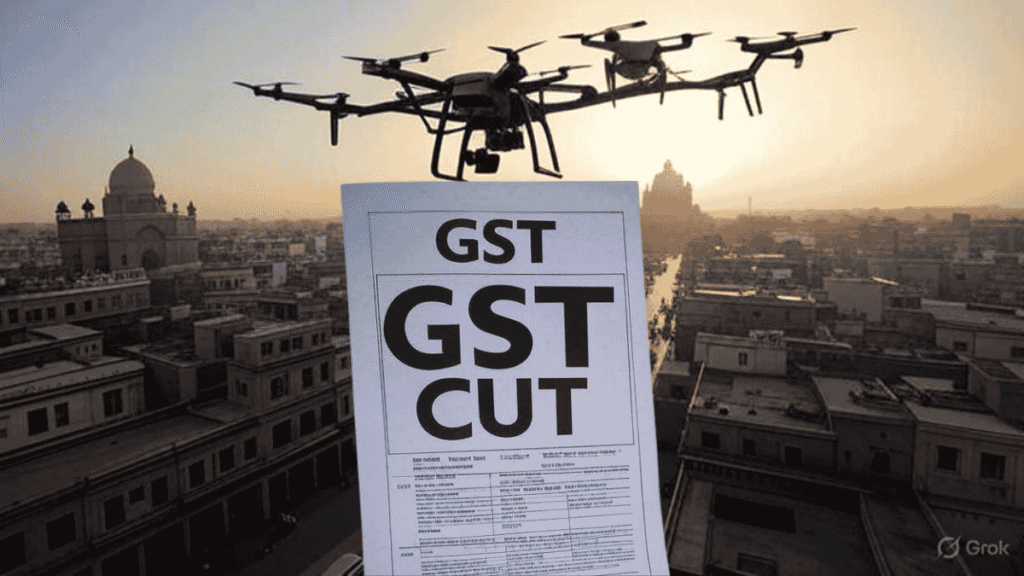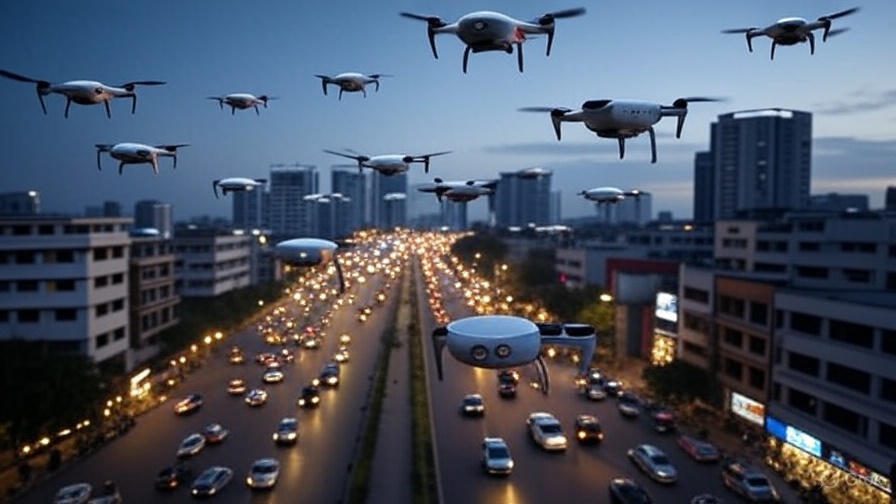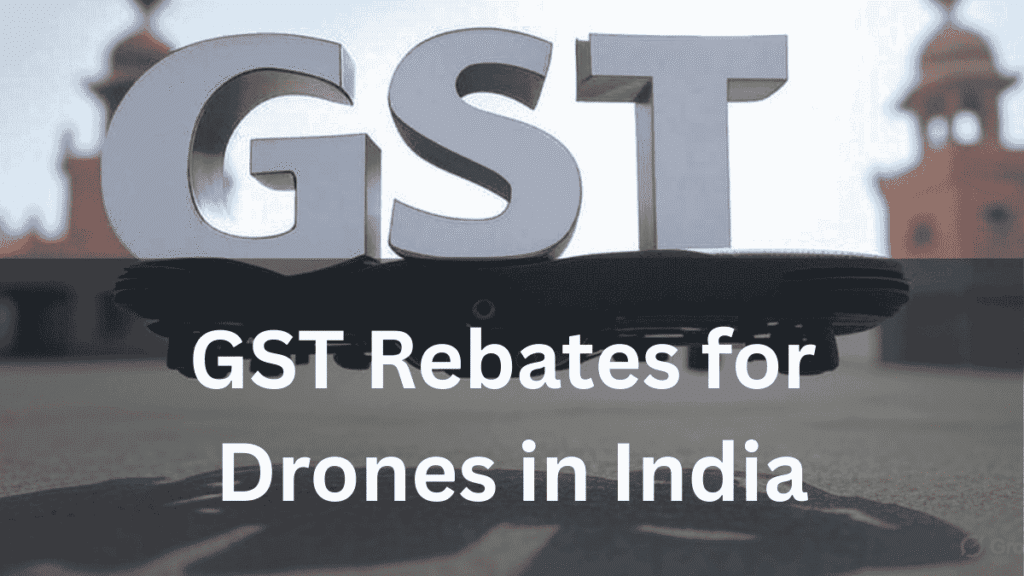In the rapidly evolving world of technology, GST rebates for drones are making headlines as a game-changer for India’s aviation sector. These GST rebates for drones, announced in the latest GST Council reforms, signal a major push towards affordable and widespread drone adoption across the country.
As we step into 2025, the Indian government has introduced transformative tax incentives under the Goods and Services Tax (GST) regime to bolster the unmanned aerial vehicle (UAV) industry. The drone GST relief measures, including a significant GST cut on drones in India, are designed to reduce costs, foster innovation, and align with the Atmanirbhar Bharat initiative.
Indian drone market has been on an upward trajectory, driven by applications in agriculture, logistics, defense, and surveillance. According to recent market analyses, the Indian drone market is projected to triple in size by 2035, reaching a valuation of over $1.5 billion, thanks to supportive policies like the Drone Rules 2021 and now these enhanced tax benefits. Prior to 2025, high GST rates—ranging from 18% to 28%—acted as a barrier, inflating costs and limiting accessibility, especially for small-scale users.
The introduction of drone GST relief in 2025 addresses these pain points head-on. By slashing taxes, the government aims to make drones more affordable, encouraging adoption in rural and urban areas alike. This isn’t just about cost reduction; it’s a strategic move to position India as a global hub for drone technology by 2030. Keywords like “GST cut on Drones in India” and “drone tax benefits” are buzzing in industry circles, reflecting the excitement around these reforms.
Understanding the New GST Rules for Drones in 2025
The 53rd GST Council meeting, held in early September 2025, brought forth sweeping changes to the tax structure for drones and related components. The most notable is the uniform 5% GST rate on commercial drones, down from the previous slab of 18-28%. This GST cut on Drones in India applies to unmanned aircraft systems (UAS) used in non-defense applications, such as agricultural spraying, delivery services, and mapping.
Additionally, military drones, flight motion simulators, and their parts are now exempt from GST entirely (0% rate). High-performance batteries and communication equipment essential for drone operations also fall under this exemption, providing a massive boost to the ecosystem. These changes are part of a broader GST 2.0 revamp aimed at simplifying taxation and promoting self-reliance in defense and aerospace sectors.
To illustrate the shift, here’s a comparison table of old versus new GST rates:
| Category | Old GST Rate (Pre-2025) | New GST Rate (From Sept 22, 2025) | Impact on Cost Savings |
|---|---|---|---|
| Commercial Drones (UAVs) | 18-28% | 5% | Up to 23% reduction in tax liability |
| Military Drones | 18% | 0% (Exempt) | Full tax relief, lowering procurement costs |
| High-Performance Batteries | 18% | 0% (Exempt) | Enables cheaper upgrades and maintenance |
| Flight Motion Simulators | 18% | 0% (Exempt) | Boosts training affordability for pilots |
| Communication Equipment | 18% | 0% (Exempt) | Enhances operational efficiency without tax burden |
This table highlights how the drone GST relief directly translates to tangible savings, making drones more competitive against traditional methods in various industries.
The rationale behind these reforms is clear: high taxes were stifling growth in a nascent sector. With the new rules, entry barriers are lowered, allowing more players to enter the market and innovate. For instance, a standard commercial drone priced at ₹10 lakh previously incurred ₹1.8-2.8 lakh in GST; now, it’s just ₹50,000, a saving of over ₹1.3-2.3 lakh per unit.
What the GST Cut Means for Drone Buyers: Step-by-Step Guidance

For individual or business drone buyers, the GST rebates for drones represent a golden opportunity to upgrade or invest without breaking the bank. The drone tax benefits not only reduce upfront costs but also improve return on investment (ROI) through lower operational expenses. Let’s break it down step by step.
Step 1: Assess Your Needs and Eligibility
Start by identifying the type of drone you need—commercial for agriculture or logistics, or perhaps a hobby model. Ensure your purchase qualifies under the 5% GST slab. Buyers of military-grade or exempt components like batteries can claim 0% GST. Verify eligibility for additional subsidies if you’re a farmer or startup (more on this later).
Step 2: Calculate Potential Savings
Use a simple formula: New Cost = Base Price + (5% of Base Price). For a ₹5 lakh drone, old tax was ₹90,000-1.4 lakh; new tax is ₹25,000—saving ₹65,000-1.15 lakh. Factor in exempted batteries: A ₹50,000 battery now costs full price without added tax, saving another ₹9,000.
Step 3: Source from Compliant Vendors
Purchase from DGCA-registered sellers or authorized importers who can issue GST invoices reflecting the new rates. Platforms like Amazon India or specialized drone marketplaces (e.g., DroneAcharya) are updating their pricing post-September 22, 2025.
Step 4: Claim Input Tax Credit (ITC)
If you’re a registered business, claim ITC on the 5% GST paid, reducing your net outflow. For exempt items like batteries, no ITC is needed since there’s no tax.
Step 5: Register and Comply with Regulations
Obtain a Unique Drone ID (UIN) via the Digital Sky platform. This ensures your drone is legally operational, maximizing the benefits of these tax cuts.
For buyers, this means drones are now 10-15% cheaper overall, accelerating adoption in surveying, photography, and delivery services. Early adopters in 2025 could see faster payback periods, especially with rising demand for drone services.
GST Benefits for Drone Startups in India: Fueling Innovation
Drone startups in India are poised to soar with these GST rebates for drones. The reduced tax burden alleviates cash flow pressures, allowing reinvestment in research and development (R&D). Founders from companies like Marut Drones and Garuda Aerospace have noted that the GST cut will lower prices by 10-15%, boosting sales and enabling expansion.
Key Benefits for Startups
- Cost Reduction on Manufacturing and Imports: With 5% GST on commercial models and 0% on components like high-performance batteries, production costs drop significantly. A startup assembling drones can save up to 20% on supply chain expenses.
- Enhanced Competitiveness: Lower prices make Indian startups more attractive globally, aligning with the Production Linked Incentive (PLI) scheme, which offers additional financial incentives for domestic manufacturing.
- R&D Boost: Savings from GST relief can be channeled into innovation. For example, startups can now afford advanced battery tech without the 18% tax overhang.
- Access to Funding: Under Startup India, eligible drone ventures can claim tax holidays (100% deduction on profits for three years) alongside these GST benefits, creating a synergistic effect.
Consider a hypothetical startup: Building a fleet of 10 agri-drones at ₹8 lakh each. Pre-2025 GST: ₹1.44-2.24 lakh per unit (total ₹14.4-22.4 lakh tax). Post-reform: ₹40,000 per unit (total ₹4 lakh tax). Savings of ₹10.4-18.4 lakh can fund prototyping or marketing.
Step-by-step guidance for startups:
- Register under Startup India for tax exemptions.
- Apply for PLI scheme via the Ministry of Civil Aviation—up to 20% incentive on incremental sales.
- Track GST compliance using tools like GSTN portal to claim credits.
- Partner with exempted suppliers for batteries to minimize costs.
- Scale operations by leveraging the Namo Drone Didi scheme for rental models.
These drone tax benefits are a lifeline for over 200 drone startups in India, potentially increasing R&D spending by 15-20% in 2025.
How Farmers Benefit from the GST Cut on Drones in India
Agriculture employs over 50% of India’s workforce, and drones are revolutionizing it through precision farming. The GST cut on Drones in India, combined with existing subsidies, makes agri-drones accessible to smallholder farmers, who previously shied away due to high costs.
Implications for Farmers
- Affordable Precision Tools: Drones for crop monitoring, spraying, and soil analysis now cost 15-20% less. A typical spraying drone (₹4-10 lakh) sees tax savings of ₹57,000-1.35 lakh.
- Increased Yields and Efficiency: With lower entry costs, farmers can adopt drone tech to reduce pesticide use by 30% and boost yields by 20%, as per ICAR studies.
- Synergy with Subsidies: The 5% GST stacks with state and central schemes, amplifying savings.
Table of Agri-Drone Subsidies in 2025:
| Scheme Name | Eligibility | Subsidy Percentage | Max Amount | Additional GST Benefit |
|---|---|---|---|---|
| Namo Drone Didi | Women SHGs (2024-26) | Up to 80% | ₹8 lakh | 5% on commercial drones + 0% on batteries |
| SMAM (Sub-Mission on Agri Mechanization) | Individual Farmers/FPOs | 40-50% | ₹5 lakh | Reduces effective cost by 45-55% post-GST |
| State Schemes (e.g., Gujarat Cotton Drone) | Agri-Drones in Specific Crops | 50% | Varies | Combined with GST cut for 60%+ savings |
| PLI for Drone Manufacturing | Startups/FPOs | 20% on Sales | Uncapped | Exempt components lower base costs |
For farmers, the drone battery GST exemption is particularly valuable—high-performance lithium-ion batteries for long-flight agri-drones are now tax-free, cutting recharge and maintenance costs by 18%.
Step-by-step for farmers:
- Check eligibility on the Agri Ministry portal (agrimachinery.nic.in).
- Apply for subsidy via CSC centers or online—requires Aadhaar and land records.
- Purchase post-September 22, 2025, to avail 5% GST.
- Train via Kisan Drone Yojana programs for safe operation.
- Rent services if buying isn’t feasible—platforms like Marut Drones offer subsidized rentals.
In 2025, over 1,000 farmers in states like Gujarat and Maharashtra have already saved ₹3-5 lakh through combined incentives, paving the way for widespread adoption.
Advantages for Service Providers in the Drone Ecosystem
Service providers—think logistics firms, surveying companies, and delivery startups—stand to gain immensely from these drone tax benefits. The GST relief reduces operational costs, enabling competitive pricing and scalability.
- Logistics and Delivery: Firms like those partnering with Swiggy or Amazon can deploy drones cheaper, shortening delivery times in remote areas.
- Surveying and Mapping: Lower costs for equipped drones (with exempt communication gear) make geospatial services more viable for infrastructure projects.
- Maintenance Savings: 0% GST on batteries and simulators cuts training and upkeep expenses by 15-20%.
For a service provider operating 20 drones: Annual tax savings could exceed ₹20 lakh, allowing fleet expansion. Step-by-step:
- Register as a Remote Pilot under DGCA.
- Invoice clients with GST-inclusive pricing reflecting new rates.
- Claim ITC on purchases.
- Integrate with Digital Sky for compliance.
- Explore B2B partnerships under PLI for volume discounts.
This positions service providers to capture a share of the $50 billion drone services market projected for India by 2030.
Spotlight on Drone Battery GST Exemption
One of the unsung heroes of the 2025 reforms is the drone battery GST exemption. High-performance batteries, crucial for extended flight times, were previously taxed at 18%, adding unnecessary costs. Now at 0%, this exemption benefits all users:
- For Buyers: Direct savings—e.g., a ₹1 lakh battery saves ₹18,000.
- For Startups: Enables development of longer-range models without tax inflation.
- For Farmers: Affordable spraying drones with better battery life reduce downtime.
- Environmental Angle: Encourages efficient batteries, aligning with green tech goals.
This exemption, effective September 22, 2025, is a boon for the entire supply chain, from manufacturers like IdeaForge to end-users.
Other Supporting Tax Benefits and Government Schemes
Beyond GST, several schemes amplify the drone GST relief:
- Startup India Tax Holiday: 3-year profit deduction for recognized drone ventures.
- PLI Scheme: ₹120 crore allocation for drone components, with incentives up to 20%.
- Export Incentives: Zero-rated GST on exports, boosting international competitiveness.
Table of Key Schemes:
| Scheme | Focus Area | Benefits in 2025 |
|---|---|---|
| Startup India | Innovation & Startups | Tax exemption + funding access |
| PLI for Drones | Manufacturing | 20% incentive on sales |
| Namo Drone Didi | Women Empowerment | 80% subsidy for SHGs |
| Kisan Drone Yojana | Agriculture | Training + 50% subsidy |
These layers create a robust support system, ensuring sustained growth.
Step-by-Step Guidance: Leveraging These Benefits Across Sectors
To maximize drone tax benefits:
- Stay Updated: Monitor CBIC and DGCA websites for notifications.
- Consult Experts: Engage CA firms for GST compliance.
- Apply for Schemes: Use portals like startupindia.gov.in.
- Purchase Strategically: Buy after September 22, 2025.
- Monitor ROI: Track savings using simple spreadsheets.
- Scale Up: Reinvest savings into training or expansion.
- Comply Fully: Adhere to NPNT (No Permission-No Takeoff) rules.
For all stakeholders, this holistic approach ensures the full potential of the GST cut is realized.
Future Outlook: Drone Adoption in 2025 and Beyond

With these reforms, 2025 marks a pivotal year for drones in India. Adoption rates are expected to surge by 30-40% in agriculture alone, contributing to the $1 trillion digital economy goal. Challenges like infrastructure and skilled pilots remain, but the momentum is undeniable. As “drone GST relief” becomes synonymous with opportunity, stakeholders must act swiftly.
FAQs On GST Rebates for Drones In India
Q1: How does the 2025 GST rebate specifically apply to drones purchased for agricultural use?
Ans: Under the new tax rules, drones categorized for agricultural purposes—such as crop monitoring, pesticide spraying, and yield estimation—qualify for an input GST rebate of up to 18%. Farmers can claim these rebates by registering drone purchases under their GSTIN and submitting evidence of agricultural application through farm registration documents.
Q2: Are drone service providers, such as aerial surveying firms, eligible for GST rebates, or do rebates apply only to drone buyers?
Ans: Both are eligible. Drone service providers can claim GST rebates on drone hardware purchases as business inputs, while buyers who purchase drone-based services benefit indirectly because providers can offer reduced service costs by utilizing their rebate credits.
Q3: Do drones imported from outside India also qualify for GST rebates under the 2025 framework?
Ans: Imported drones qualify only if they are classified under the Harmonized System (HS) code recognized for drone hardware and registered with the Directorate General of Foreign Trade (DGFT). However, import duties are separate from GST rebates, so while GST paid at the point of import can be rebated, customs duties remain non-refundable.
Q4: How do businesses in logistics and delivery sectors benefit differently from agricultural users when claiming GST rebates on drones?
Ans: Logistics companies can claim GST rebates as input tax credits against their service output liabilities. Since logistics services often fall under higher GST brackets (12–18%), using drones reduces taxable supply costs significantly. In contrast, agricultural users primarily leverage rebates as cost relief on capital equipment, with fewer output GST obligations.
Q5: Are drone accessories like batteries, sensors, and thermal cameras covered under the GST rebate rules of 2025?
Ans: Yes, accessories that are deemed “integral components” of drone operations are rebate-eligible, provided invoices are itemized and linked to drone GSTIN registration. Luxury add-ons, such as high-end filming gear not tied to commercial or agricultural use, may be excluded.
Q6: How can small-scale drone startups with limited GST output liabilities fully utilize input rebates without losing credit balances?
Ans: Startups can apply for a GST refund of accumulated input credits under the “inverted duty structure” rule. If their drone purchases are taxed at a higher rate than their services, they can file for refunds rather than carrying forward unused credits.
Q7: Do state-level GST variations impact drone rebate eligibility in 2025, or are rebates standardized across India?
Ans: The rebate structure is standardized under the Central GST (CGST) and Integrated GST (IGST) framework. However, State GST (SGST) administration may vary in documentation rigor, especially regarding proof of drone application (e.g., agriculture vs. entertainment). Businesses should verify compliance with their local GST commissioner.
Q8: Are drones leased under financial agreements eligible for GST rebates, or does ownership play a role in rebate claims?
Ans: Leased drones are eligible if the leasing company issues GST-compliant invoices reflecting GST charges. The lessee can claim input credits on lease payments. Ownership is not mandatory, but the lessee must demonstrate business use under GST guidelines.
Q9: How does the rebate system treat drones used for dual purposes, such as both agricultural mapping and wedding photography?
Ans: Dual-purpose drones are subject to proportionate credit rules. Businesses must apportion GST input credits based on the percentage of taxable vs. exempt services. For example, commercial agricultural use is rebate-eligible, but event photography (often taxed under entertainment services) may restrict full rebate claims.
Q10: Will the GST rebate program for drones continue beyond 2025, or is it a temporary incentive?
Ans: The rebate scheme is structured as a three-year incentive window (2025–2028) to accelerate drone adoption. However, government reviews are scheduled annually, and continuation will depend on adoption rates, revenue implications, and drone sector growth.
Conclusion
The GST rebates for drones are more than tax tweaks—they’re a catalyst for innovation and inclusivity. From drone buyers saving thousands to farmers revolutionizing fields and startups fueling R&D, the benefits are profound. As India eyes global leadership in UAVs, embracing these drone tax benefits will be key to unlocking a soaring future. Stay informed, comply, and take flight in 2025!

